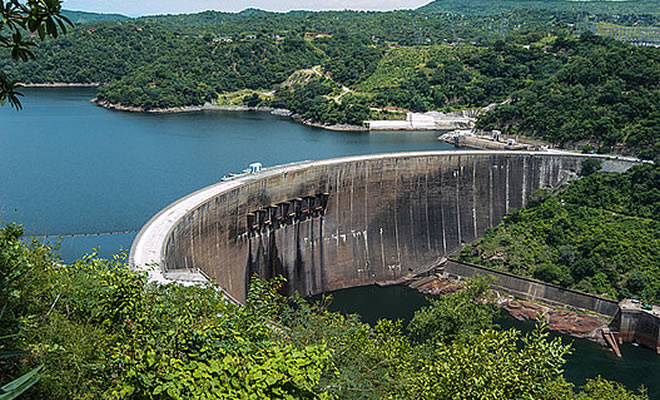A catastrophic failure of the Kariba Dam on the border between Zimbabwe and Zambia would put three and a half million lives at risk and knock out forty per cent of southern Africa’s hydroelectricity supply, according to a recent report.

The report by the Institute of Risk Management of South Africa entitled “Impact of the Failure of the Kariba Dam” warned that 181 billion cubic metres of water could be released if the dam wall failed. Eight hours later this wall of water would hit and destroy the Cahora Bassa dam in central Mozambique.
The report states that the lake behind the Kariba Dam is the largest man-made reservoir in the world. The dam was commissioned in 1960 and is central to the power requirements of Zimbabwe and Zambia. It has a maximum output of 1,839 megawatts. Further down the Zambezi River, Cahora Bassa has a maximum output of 2,075 megawatts.
However, the water gushing out of the Kariba Dam’s sluices has been eroding the rock at the bottom of the dam. Originally the water was only ten metres deep at the foot of the dam, but erosion of this plunge pool has increased the depth to ninety metres and has been wearing away rock near the dam’s foundations.
Plans have been drawn up to remedy this by increasing the size of the plunge pool, which will involve blasting up to 300,000 cubic metres of rock. In addition, work will be carried out on the dam’s floodgates and the concrete will be inspected to analyse the extent of damage to the structure’s concrete caused by chemical reactions. This work is expected to take ten years to complete as only one floodgate can be repaired at a time.
The report references an article in the South African paper “Business Day”, from 17 February which stated that “the consensus of engineers from around the world is that Kariba has a life span of three years if extensive repairs are not undertaken immediately”.
In an interview with AIM, the report’s author, Kay Darbourn, warned that the likelihood of dam failure increases the longer it takes to get started on the repairs. She pointed out that if the current drought continues there is less of a danger, but questioned whether the dam will be able to cope with a drastic increase in water during the rainy season.
This view was shared by Dr Richard Beilfuss who, writing about climate change in a report for the non-governmental organisation International Rivers, stated that “more frequent extreme floods threaten the stability and safe operation of large dams. If dams are “under-designed” for larger floods, the result could be serious safety risks to millions of people living in the basin”.
Although Darbourn is not an engineering expert, she is hugely experienced in risk management, which involves the identification, evaluation and treatment of risks and opportunities.
Some of her suggestions would be easy to implement and could save many hundreds of thousands of lives. Thus SMS text messages and social media such as Twitter and Facebook could be used to give advanced warning of any threatened or occurring danger. There are already international SMS services that warn people of the danger of Tsunami’s in the Pacific Ocean.
The technical director of Hidroelectrica de Cahora Bassa (HCB), the company that operates the Cahora Bassa dam, Moises Machaba, told AIM that HCB has been aware of the risk to Kariba for some time.
“The dam operators on the Zambezi have an association, and there are memorandums of understanding signed by the companies and by the governments, which concern exchange of information on the management of the river”, he said.
There were thus regular meetings between HCB and the Zambezi River Authority (ZRA), which operates Kariba, and in these meetings questions of safety, including the danger to the Kariba dam had been discussed.
According to Machava, the latest information is that the risk exists, but is not imminent. “It won’t happen tomorrow, or next year”, he said. “But if nothing is done, then it will happen, but not for another couple of years at least”.
The Zimbabwean and Zambian governments signed agreements on 18 September with the European Union, World Bank, African Development Bank and the Swedish government to finance the repairs, to the tune of 294 million US dollars.
“It was considered an emergency and the EU decided to mobilise funds as it was important to start the rehabilitation as soon as possible,” Philipe Van Damme, the EU ambassador to Zimbabwe, told reporters.
The repairs could take up to a decade. Charity Mwansa, chairperson of the Zimbabwe River Authority (ZRA), which operates the dam, said the “reshaping of the plunge pool will take three years, while the rehabilitation of the spillway gates will take six years with minimal disruptions to normal operations.”
Machava said HCB does not know when these repairs will begin, but given the urgency of the situation, he expected that date to be later this year or in early 2016. HCB expects to be briefed on this at the next meeting of the dam operators in early December.
The drought affecting the upper Zambezi means that the structural condition of the dam is not getting much worse at the moment. The condition of the plunge pool worsens when the floodgates are open, and currently none of the Kariba floodgates are open.
Machava said the Kariba reservoir is currently 20 per cent lower than normal. ZRA had told HCB that it is keeping the floodgates closed, and does not intend opening them, even if it begins to rain. AIM






